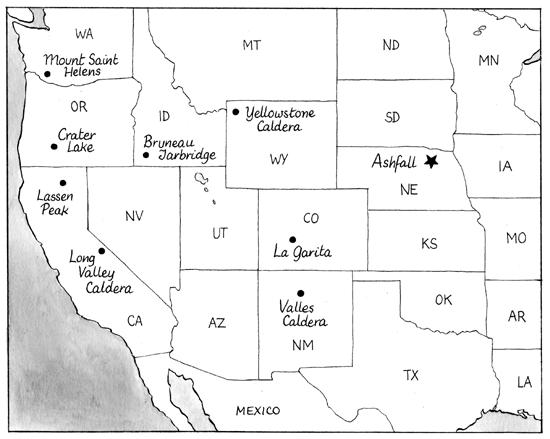

Section A: Volcanic Identification -- Data from the Ashfall Fossil Beds
Identify the type of volcano that created the Ashfall Fossil Beds site. First compare the Ashfall Data with information about three main types of magma (mafic, intermediate, felsic) listed in the Magma and Eruption Characteristics chart. Then fill in the Ashfall Conclusions section with your conclusions.
Ashfall Data
Ash Composition (percentage by weight) from Ashfall
|
Aluminum Oxide |
Calcium Oxide |
Iron Oxide |
Potassium Oxide |
Magnesium Oxide |
Sodium Oxide |
Titanium Dioxide |
Phosphorous Pentaoxide |
Silicon Dioxide |
|
11.80 |
0.60 |
2.80 |
6.30 |
0.10 |
2.60 |
0.20 |
0.08 |
75.50 |
*combined concentration of FeO and Fe2O3
General Magma and Eruption Characteristics
|
Mafic |
Intermediate |
Felsic | |
|
Ash |
48-52% SiO2; high in FeO, MgO, CaO; low in K2O, A12O3, Na2O |
53-65% SiO2; moderate amounts of all major compounds |
>65% SiO2; high in K2O, A12O3, Na2O; low in FeO, MgO, CaO |
|
Magma Characteristics |
High eruption temperature |
Medium eruption temperature (900°C-1000°C); medium resistance to flow (somewhat thicker, sticky lava) |
Low eruption temperature (600°C- 900°C); high to very high resistance to flow (very thick, sticky lava) |
|
Eruptive Characteristics |
Relatively non-explosive; extensive lava flows |
Relatively explosive; pyroclastic flows, ash falls, tephra deposits, volcanic gases, lahars |
Highly explosive; enormous dark columns of tephra and gas high into the stratosphere; pyroclastic flows and surges; extensive ash fall |
|
Common Lava/Tephra Type Produced |
Balsitic |
Andesitic |
Dacitic/Rhyolitic |
|
Dominant Volcano Form |
Cinder cones |
Composite cones (Stratovolcanoes) |
Calderas |
Answer the following questions before going to the next section.
Type of ash at Ashfall (mafic / intermediate / felsic): _____________________________________________
Type of eruption most likely to have created Ashfall: _____________________________________________
Type of volcano form most likely to have created Ashfall: _________________________________________
Section B: Volcano Suspects
Data Set #1: Location
Use print and Internet resources to determine the approximate distances between the Ashfall Fossil Beds site and each volcano.
Answer the following questions before going to the next data set.
-
Which volcano is located closest to the Ashfall site?
-
Which volcanoes are farthest away?
-
Based on the data so far, which volcano seems to be the most likely suspect?
Complete the Location information in the Volcano Suspects Table at the bottom of the page.
Data Set #2: Description
DATA SET #2: Description
Answer the following questions before going to the next data set.
-
The eruptive volume corresponds to the explosiveness of a volcano. Which volcano had the most explosive eruption? Which had the least explosive eruption?
-
Does there seem to be a relationship between the size of a volcano's crater/caldera and an eruption's explosiveness? Why or why not?
-
Based on the data so far, which volcano seems to be the most likely suspect?
Complete the Description information in the Volcano Suspects Table at the bottom of the page.
Data Set #3: Ash Composition
The following represents a breakdown of the average concentration of major compounds (percentage by weight) in the ash from each volcano.
|
Ash Sample |
Aluminum Oxide |
Calcium Oxide |
Iron Oxide |
Potassium Oxide |
Magnesium Oxide |
Sodium Oxide |
Titanium Dioxide |
Phosphorous Pentaoxide |
Silicon Dioxide |
|
Mount St. Helens |
14.70 |
1.81 |
1.39 |
2.01 |
0.46 |
4.45 |
0.17 |
0.04 |
74.80 |
|
Crater Lake |
14.79 |
1.58 |
1.85 |
2.77 |
0.32 |
5.21 |
0.43 |
0.09 |
72.39 |
|
Lassen Peak |
13.99 |
2.03 |
1.99 |
3.43 |
0.88 |
3.64 |
0.35 |
0.10 |
73.47 |
|
Long Valley Caldera |
13.24 |
0.40 |
0.70 |
5.06 |
0.07 |
2.92 |
0.07 |
0.01 |
72.42 |
|
Valles Caldera |
12.43 |
0.45 |
1.52 |
4.74 |
0.05 |
3.74 |
0.08 |
0.01 |
74.77 |
|
Bruneau-Jarbridge |
11.90 |
0.80 |
2.70 |
6.10 |
0.10 |
2.50 |
0.10 |
0.08 |
75.60 |
|
Yellowstone Caldera |
11.71 |
0.56 |
1.90 |
5.57 |
0.15 |
2.75 |
0.23 |
0.01 |
76.49 |
|
La Garita |
12.50 |
0.56 |
1.10 |
4.80 |
0.01 |
2.38 |
0.10 |
0.02 |
77.10 |
*combined concentration of FeO and Fe2O3
Answer the following questions before going to the next section.
-
For each suspect volcano, would you characterize the magma that produced the ash sample as mafic, intermediate or felsic? Why?
-
Which ash seems to be most similar in composition to the Ashfall sample?
-
Based on the data, which volcano seems to be the most likely suspect?
-
How confident are you that your answer is correct?
Complete the Ash Composition information in the Volcano Suspects Table at the bottom of the page.
Section C: Identifying the Volcano Responsible
Now that you have analyzed all three data sets and filled out your Volcano Suspects Table, identify your main suspect and answer each of the questions listed below.
-
Most of the listed suspect volcanoes have calderas, which are large depressions formed by the collapse of the summit or flanks of a volcano during a large-scale, highly explosive eruption. Why would a caldera-forming eruption be the most likely source of the ash found in Nebraska?
-
The most explosive volcanoes have magma with a very high silica (SiO2) content. Based on this information, which of the suspect volcanoes is most likely to have had the most explosive eruption?
-
Which volcano do you think was the most likely source of the eruption that killed the animals in Nebraska? Why?
-
Did your opinion change as you analyzed more data? Why or why not?
-
Which data were most relevant?
-
Which were least relevant?
Volcano Suspects Table
|
Data Set |
Mount St. Helens |
Crater Lake |
Lassen Peak |
Long Valley |
Valles Caldera |
La Garita |
Bruneau- |
Yellow- |
|
Location |
||||||||
|
Description |
||||||||
|
Ash |
Remember to send your answers to the six questions above and your completed Volcano Suspects Table!







